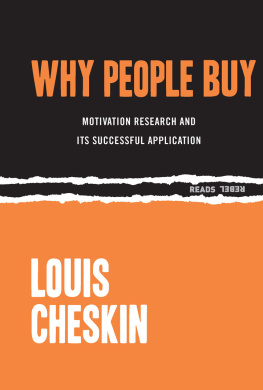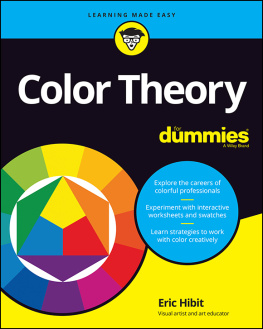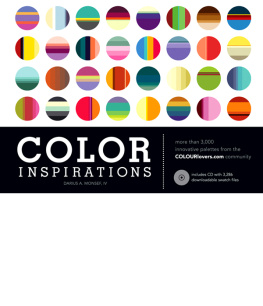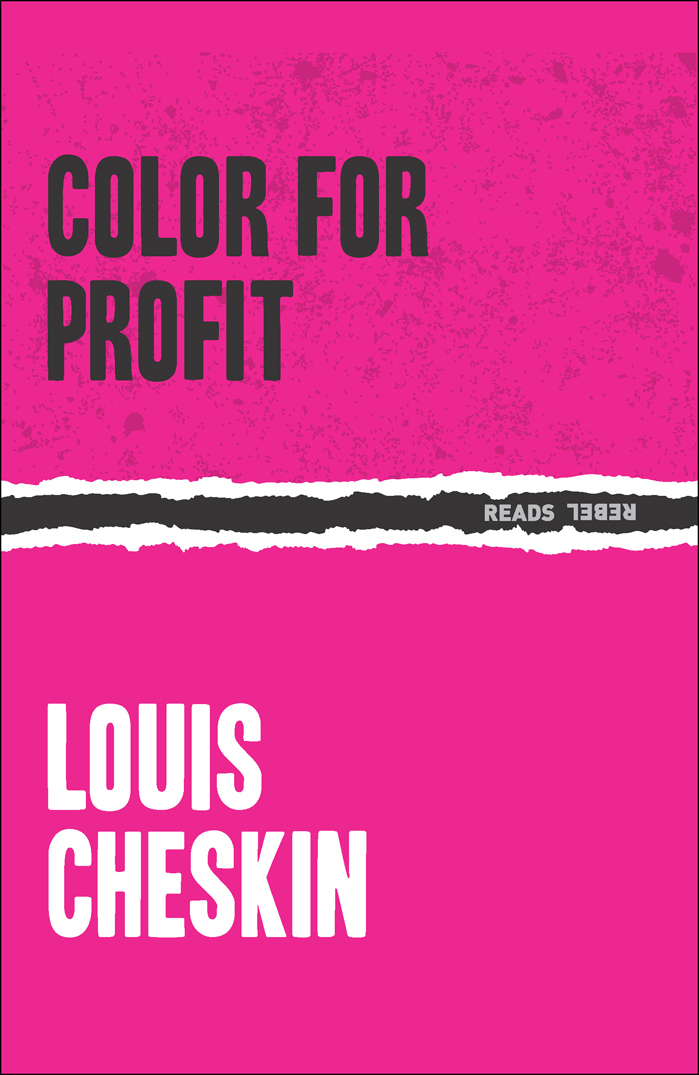


Copyright 1951 by Liveright Publishing Corproation
Reissue Edition
No part of this book may be used or reproduced in any manner without written permission of the publisher.
Please direct inquiries to:
Ig Publishing
Box 2547
New York, NY 10163
www.igpub.com
ISBN: 978-1-63246-035-6 (ebook)
This book is dedicated to the progressive business and advertising executives, sales people and commercial artists.
Table of Contents
Guide
CONTENTS
You can make color printing and color display profitable by using color and design scientifically.
Marketing research of the polling type, based on conscious reactions, is not reliable.
People are neither able nor willing to reveal their true feelings nor to predict their own behavior.
The conscious mind often rejects advertising but the unconscious is influenced by it.
There are color associations that are normal, traditional and social. However, there are individuals whose reactions to colors are neither normal, traditional, nor social.
It is probable that because red was associated with a painful experience, a baby girl grew up with a strong dislike for red.
The parents did not discover that there was a relationship between the childs abnormal behavior and the fathers blue suit.
There are many adults who have strong color phobias due to a traumatic experience associated with a color in early childhood.
Behavior patterns are formed through habit and association.
People avoid complicated patterns. Intricate package designs are difficult to identify and remember. Yet the masses of people associate intricacy and great detail with great art because of traditional concepts.
I may have a friendly attitude toward a sign. That does not mean that I will be attracted by the sign or that it will influence me.
In order to use images and colors as tools for marketing, we must learn which produce favorable sensations and which unfavorable.
The simpler the image the higher the preference and retention ratings.
Most of the preference tests conducted by Color Research Institute are of the free association type and are made on an unconscious level by an indirect method.
For physical and optical reasons it is just as natural for normal people to like complementary colors as it is to walk upright.
Persons who show abnormal color preference also possess other abnormal characteristics.
The preference rating of a color is conditioned not only by its specific value but also by the presence of other colors, by the area it occupies and by the object with which it is associated.
Reactions to colors often demonstrate emotional conflict.
When a design or advertising page is before a persons eyes, it constitutes the sum of all the optical sensations.
An eye-movement test determines how the eyes travel over the package or advertising page.
One color has the power to attract; the other is pleasant to look at. The same color rarely has both attributes.
Customers like to patronize stores that have friendly clerks and pleasing, harmonious interiors, although they are generally not aware that colors are mainly responsible for their desire to patronize such stores.
The fashion and furniture industries would profit greatly by understanding the psychological elements of ego involvement and prestige identification.
Designs that flatter the figure will always remain popular. The color that has a high preference rating and is at the same time flattering to the flesh tones of most people will always be a best seller.
The package frequently is responsible for the greatest number of sales.
In modern merchandising the package is a psychological tool planned to convey the character of the contents and to serve as an effective display.
In a package design, colors should have maximum psychological appeal, be symbolic of the contents and have highest visibility.
Factors to consider are the size of the package, dimensions, shape, ease of handling, the space it will occupy, and the way in which the package is to be opened.
The display must attract attention and create a desire to examine the merchandise.
Color lights can be used effectively for providing attractive color environment.
Well-designed counter and floor displays will attract attention and hold interest.
The poster must attract people on the go.
The psychological effect of the specific color on the social group it will reach and the symbolic relationship of the color to the product are important.
Scientific methods have taken pictorial effectiveness out of the realm of speculation and personal preference.
Color can imbue the message with personality and distinction.
Changing from black and white to full color ads created 500 per cent increase in business.
The envelope provides the first contact and creates favorable or unfavorable impressions.
The enclosure should be organized in keeping with the principles of composition and eye-movement.
Increases up to 450 per cent in direct mail returns have been reported by companies that have changed from black and white to color.
For those who desire to go deeper into the scientific aspects of color
Colors are the basic components of light. Light has colors only when it comes in contact with matter (substance). Color is actually a manifestation of the relationship between visible energy (light) and matter (substance).
Although the source of color is physical, the substances from which pigment colors are produced are chemical.
The human eye is anatomically and physiologically equipped to receive all waves of visible energy (white light) as well as sections or divisions of visible energy (colors).
Tests, analysis, recommendations, and meaning of ratings.
ILLUSTRATIONS
This book was prepared specially for those business executives, market researchers, advertising people, commercial artists, display men and creative salesmen who seek knowledge about using color and design as marketing tools. The material in this book does not deal with personal or subjective opinions but with the scientific application of color and design.
Using color and design scientifically means determining, by testing under controlled conditions, the optical and psychological effect of specific colors and images. It means eliminating personal taste and subjective judgment in choosing designs and colors for store and window displays, for packages, direct mail pieces and all advertising matter.
After reading this book it will become apparent that you cannot depend on personal judgment in using color and design as tools in marketing. You will learn why other peoples opinions regarding a piece of art or a color are not reliable guides. You will also become aware that polling gives no more accurate information about markets than about national elections.
The scientific procedures of testing color and design effectiveness and the psychological aspects of home furnishings, wearing apparel and store interiors are discussed in the first part of the book. The second part covers the application of color and design in the fields of package design, window displays, counter and floor displays, display posters, publications advertising and direct mail advertising as well as in all types of printed literature.
















